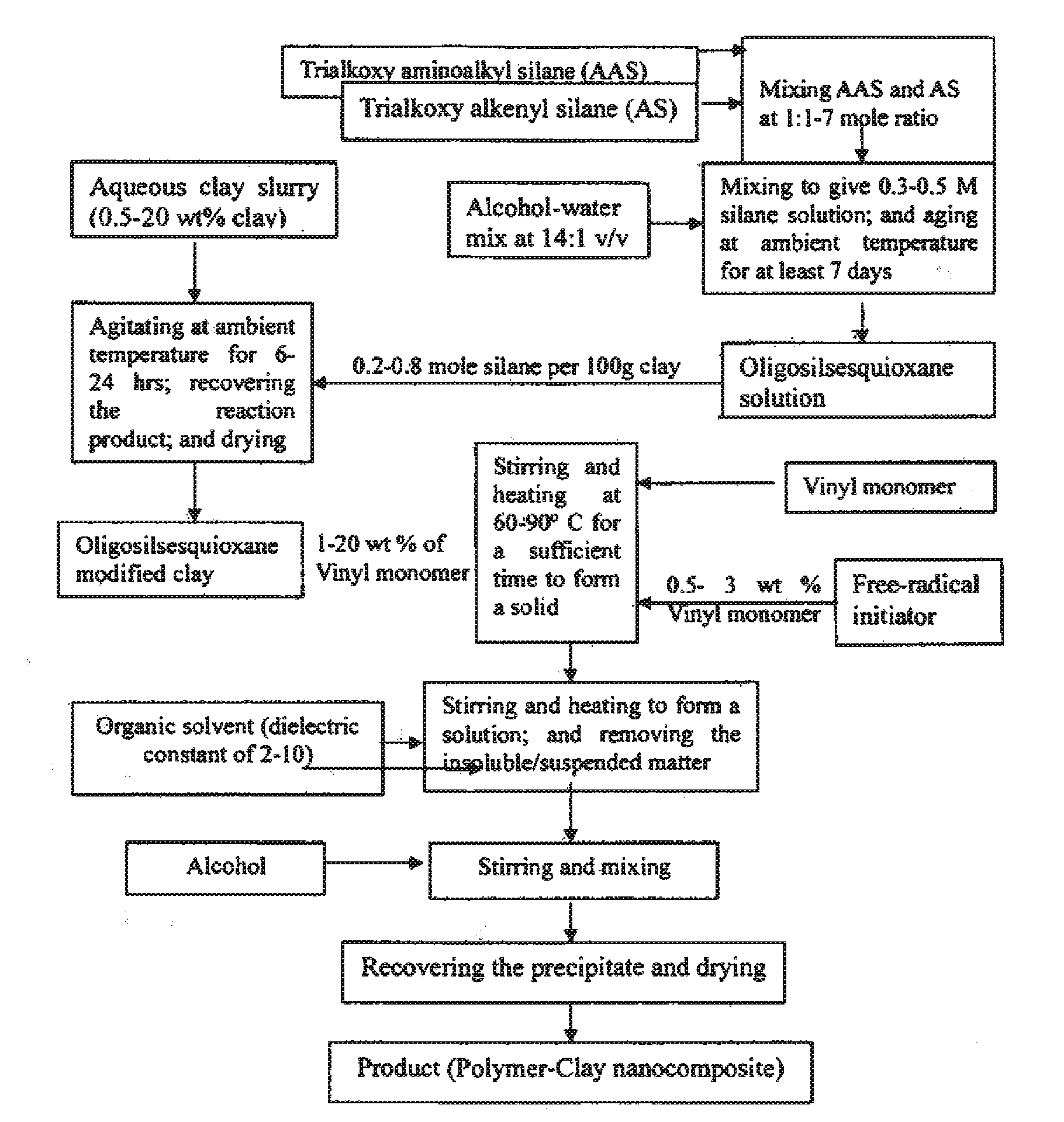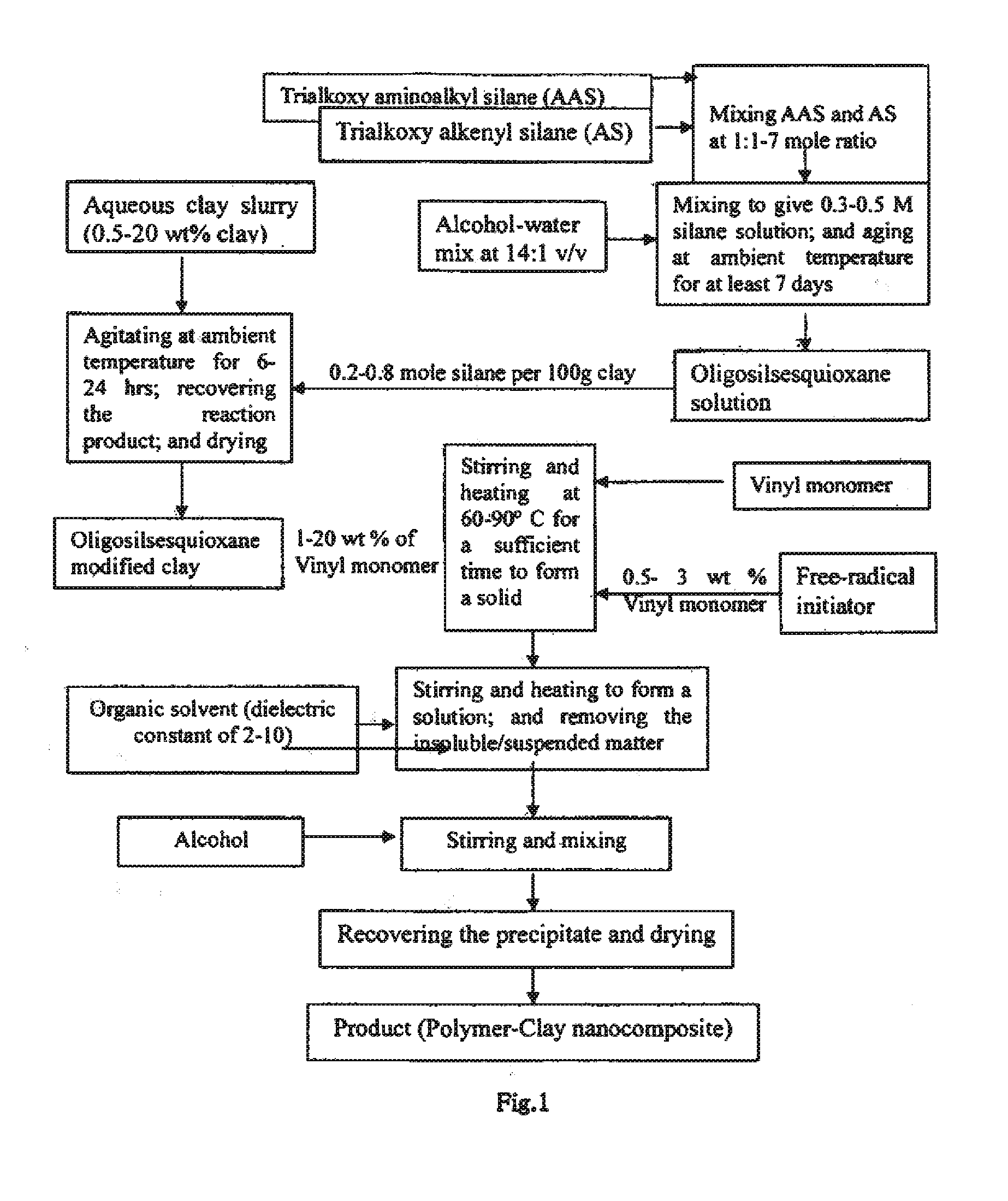Clay nanocomposite forming microcapsule useful for guest encapsulation and process thereof
- Summary
- Abstract
- Description
- Claims
- Application Information
AI Technical Summary
Benefits of technology
Problems solved by technology
Method used
Image
Examples
example 1
[0068]Preparation of Nanocomposite.
[0069]A mix of 3.32 g (0.015 mole) of (3-aminopropyl)triethoxy silane and 4.76 g (0.025 mole) of vinyl triethoxy silane, diluted to a volume of 100 ml with ethanol-water mixture of 14:1 v / v ratio and aged at ambient temperature in a suitable closed container for a period of 10 days was added to slurry of 10 g of montmorrillonite clay in 500 ml water in a suitable vessel, agitated at ambient temperature for a period of 24 hrs, filtered and the residue was washed with ethanol, and vacuum dried at a temperature of 60° C. A mix of 5 g of the dried residue, 110 ml of vinyl benzene and 1.5 g of dibenzoyl peroxide, in a two-necked flask, under vigorous stirring and nitrogen atmosphere, was heated at 80° C. for a period of 3 hrs, added 500 ml of toluene and refluxed to form a solution, cooled to ambient temperature, centrifuged at 4000 RPM and the clear supernatant solution was concentrated to 200 ml, stirred with 100 ml of methanol, filtered and the resid...
example 2
[0074]Preparation of Nanocomposite.
[0075]A mix of 2.85 g (0.015 mole) of trimethoxy [3-(methylamino)propyl] silane and 6.66 g (0.045 mole) of vinyl trimethoxy silane, diluted to a volume of 130 ml with ethanol-water mixture of 14:1.2 v / v ratio and aged at ambient temperature in a suitable closed container for a period of 7 days was added to a slurry of 10 g of montmorrillonite clay in 1000 ml water, in a suitable vessel, agitated at ambient temperature for a period of 36 hrs, filtered and the residue was washed with ethanol, and vacuum dried at a temperature of 60° C. A mix of 8 g of the dried residue, 100 ml of allyl benzene and 2 g of dicumyl peroxide, in a two-necked flask, under vigorous stirring and nitrogen atmosphere, was heated at 105° C. for a period of 4 hrs, added 300 ml of toluene and refluxed to form a solution, cooled to ambient temperature, centrifuged at 4000 RPM and the clear supernatant solution was stirred with 250 ml of ethanol, filtered and the residue was dried...
example 3
[0080]Preparation of Nanocomposite.
[0081]A mix of 3.98 g (0.018 mole) of 3-aminopropyl triethoxy silane and 3.68 g (0.018 mole) of allyl triethoxy silane, diluted to a volume of 100 ml with ethanol-water mixture of 14:0.8 v / v ratio and aged at ambient temperature in a suitable closed container for a period of 7 days was added to a slurry of 10 g of bentonite clay in 700 ml water, in a suitable vessel, agitated at ambient temperature for a period of 18 h, filtered and the residue was washed with ethanol, and vacuum dried at a temperature of 60° C. A mix of 12 g of the dried residue, 100 ml of vinyl benzene and 3 g of dilauroyl peroxide, in a two-necked flask, under vigorous stirring and nitrogen atmosphere, was heated at 60° C. for a period of 4 hrs, added 400 ml of o-xylene and refluxed to form a solution, cooled to ambient temperature, centrifuged at 4000 RPM and the clear supernatant solution was concentrated to 200 ml, stirred with 300 ml of ethanol, filtered and the residue was ...
PUM
| Property | Measurement | Unit |
|---|---|---|
| Temperature | aaaaa | aaaaa |
| Temperature | aaaaa | aaaaa |
| Temperature | aaaaa | aaaaa |
Abstract
Description
Claims
Application Information
 Login to View More
Login to View More - R&D
- Intellectual Property
- Life Sciences
- Materials
- Tech Scout
- Unparalleled Data Quality
- Higher Quality Content
- 60% Fewer Hallucinations
Browse by: Latest US Patents, China's latest patents, Technical Efficacy Thesaurus, Application Domain, Technology Topic, Popular Technical Reports.
© 2025 PatSnap. All rights reserved.Legal|Privacy policy|Modern Slavery Act Transparency Statement|Sitemap|About US| Contact US: help@patsnap.com



